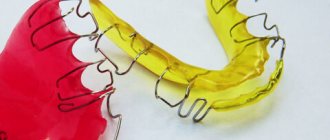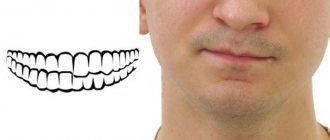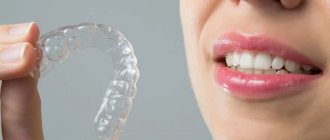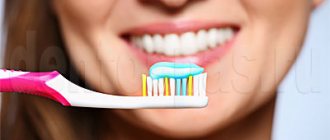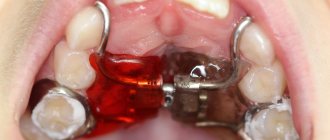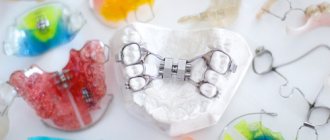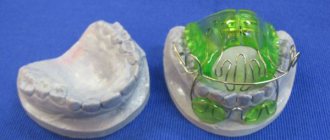20392
To date, many different designs have been developed in orthodontics to correct malocclusion and dental irregularities in children. One of the most common devices is the Frenkel apparatus.
It is an excellent alternative to vestibular plates and the traumatic arc of Engle . The device differs from them not only in its more convenient design, but also in a shorter treatment period.
Production
The device is created by specialists in a dental laboratory. It is removable and can be installed on two jaws at once. The design includes the following elements:
- frame;
- cheek shields;
- lip pelota.
The frame is made of durable metal wire, which is formed into arcs. There are several of the latter in the product:
- palatal;
- lingual;
- vestibular;
- lingual (added in some cases).
Pilots and shields are special flaps to limit unnecessary force. They can be either metal or plastic. The width is determined by the degree of pathology, but does not exceed two and a half millimeters. All elements are polished to avoid injury to the periodontium and dentin.
The product is manufactured individually for each patient. The basis is taken from impressions and impressions of teeth made in advance.
General overview
In dental practice, various methods are used to correct anomalies - physiotherapeutic and surgical methods, therapeutic exercises, special orthodontic structures.
The hardware method of treatment is the main one; it can be used to correct the most complex dental anomalies. However, this may require years of wearing orthodontic appliances.
Doctor, MD L. S. Persin developed two devices for correcting the position of teeth - for distal and mesial occlusion. According to the principle of operation, both of them are functional or passive.
This means that correction with their help is carried out thanks to the work of the maxillofacial muscles , i.e., during the performance of the function.
Both models are removable. When they are in the mouth, you cannot talk or eat. To achieve a corrective effect, they must be worn at least 14 hours a day.
The device for correcting distal occlusion is single-jaw, for mesial occlusion it is double-jaw.
How treatment is carried out with the Klammt activator and what it is.
Come here if you are interested in how the Bertoni screw plate works.
At this address https://zubovv.ru/ortodontiya/treyneryi/mogut-li-zamenit-brekety.html we will talk about the purpose of orthodontic trainers for teeth.
Kinds
There are several types of Frenkel function regulator, each of which has its own characteristics. The doctor selects the appropriate option depending on the nature of the existing pathology and its severity.
FR-1
There are three types:
- FR-la;
- FR-lb;
- FR-lc.
The basis of the design is the lingual and palatal arches, which are fastened with pelotas. The main indication is a distal bite with incisors inclined forward. During the correction process, the dentition expands to create free space. As a result, the front teeth are given the opportunity to grow properly.
FR-2
This device is used to correct distal occlusion, combined with an inclination of the upper incisors towards the palate.
Peculiarities:
- special shape of loops;
- double pilots.
Fr-3
The device differs significantly from other types in its design. There are special side pads. Lip patches are fixed only in the upper lip area. The third type of adjuster is prescribed to correct mesial occlusion caused by lower prognathism or excessive development of the lower jaw.
Fr-4
The vestibular arch is installed on the upper dentition, and the pelota on the lower lip. Indication for use: open bite. The device eliminates factors inhibiting the growth of the lower jaw. Metal overlays on the sides of the dentition allow you to separate the bite and achieve dentoalveolar shortening.
Pathology treatment period
The duration of treatment for a dental anomaly will directly depend on its complexity and the age of the patient. The more severe the problem and the older the client, the less effective this device is. For children 4-11 years old, correction can take place very quickly and will be quite effective. It will take 4 to 8 months to correct such an anomaly. For complex pathologies, the treatment period can be extended to 1.5 years. In addition, you should take into account the structural features of each child’s jaw and compliance with the operating procedure of the device. Another special feature of the design is that it should be worn exclusively at night and for several hours during the day. The result becomes visible within the first 2-4 months of use. If the jaw grows, it is important to replace the structure as the system grows. Over a period of 1.5 years, replacement will be made up to three times.
Manufacturing cost
The structure is installed in a special clinic and under the guidance of an experienced doctor. First, the patient is examined, then an impression is taken and sent to the laboratory for the manufacture of the device. At this time, the specialist prepares the patient’s oral cavity for installation of the device. To do this, the teeth are examined for caries, all old fillings are replaced, and the tooth enamel is strengthened by applying a special composition.
As for manufacturing, the cost of work can be 7-18 thousand rubles. The price directly depends on the type of structure. For example, the first type of construction costs 7 thousand rubles, and the second and third types cost 13 thousand rubles. The fourth type costs about 18 thousand rubles. The indicated prices do not include the cost of treatment, which can reach 50 thousand rubles. According to reviews, the device is very effective and allows the patient to quickly adapt.
Advantages and disadvantages of the device
In fact, the Angle apparatus is a prototype of the current braces system. Mechanimz affects almost the entire range of pathologies in the functioning of the dental system. The design is easy to use and does not depend on the state of the muscles of the system. Despite this, the design can have a number of side effects:
- a wire system can injure the gums or damage tooth enamel;
- the arch harms the integrity of the bone in the jaw system, so the use of this design is contraindicated for children;
- may cause displacement of supporting teeth if the impact is too intense;
- provokes necrotic deformation of tissues as a result of strong compression of blood vessels.
Manufacturing and use of the device
The creation process involves taking an impression of the client's teeth, which subsequently serves as a model for creating crowns and arch shapes. The action of the device is based on the influence of pressure and therefore there must be a fulcrum. These are considered healthy teeth – molars. In some cases, pressure can cause healthy teeth to shift, and then the installed device will no longer have any effect. The cost of manufacturing the structure is 1.5-2.5 thousand rubles, and additional services are about 2 thousand rubles. The duration of treatment depends on the complexity of the pathology.
Wearing rules and care
Before starting therapy, the orthodontist gives detailed recommendations on the use and care of the regulator. The device should only be worn while sleeping because you should not chew or talk while wearing it. To enhance the effect, you can wear it for an additional three hours during the day. It does not cause discomfort to small patients (unlike many other orthodontic structures). Another advantage is the rapid adaptation period.
During the treatment process, you will need to change the product 2-3 times, because the child’s jaws are actively growing, and the effectiveness of the correction may decrease.
The device must be cleaned regularly to avoid the accumulation of bacteria on its surface. If you neglect proper care, this is fraught with the development of caries.
Operating principle
Unlike many other devices, correction of occlusion here is achieved by influencing the structural elements on individual muscles, processes of the alveolar ridges and areas of the dentition.
Due to this, the apical base, occlusal relationship, and movement of the tooth body are normalized.
The device allows you to eliminate excessive pressure on the lips and cheeks on problem areas, normalize the function of nasal breathing, proper closure of the lips, and form the desired position of the tongue .
Due to its wide capabilities, this device was called a function controller. The main importance in this design are shields and pads, which stimulate the expansion of the apical base in all directions and form the correct functioning of the muscles.
The main importance when using this device is the regulation of muscle tone. The design is made in such a way that it leads to relaxation of certain muscle groups in problem areas, as a result of which the correction is painless.
Elastic positioners have been developed for this device, which have a completely different appearance, but have the same functional effect as the Frenkel device.
Its difference lies in the possibility of combining elements to adapt to a specific problem, which significantly increases the effect of treatment .
Are there any contraindications
The device is ineffective for treating adults and patients in the later stages of development of the dental system.
Also, the effect of use will not be with other malocclusions - cross, deep and open.
Otherwise, the device has no contraindications - if a child is allergic to the materials from which the device is made, a hypoallergenic analogue is selected at the development stage.
Review of the design of the functional Frenkel apparatus and its purpose.
In this publication we will consider the stages of manufacturing the Engle apparatus.
Here https://orto-info.ru/sistemyi-vyiravnivaniya-zubov/lechebno-profilakticheskie-apparatyi/basharovoy.html we will find out what the Basharova apparatus does.
Purpose
Let's consider the Persin device, designed for the treatment of distal occlusion. This anomaly is characterized by pathological protrusion of the upper teeth in relation to the lower teeth when the jaws are closed.
The anomaly has the following symptoms:
- "Bird's face" The upper jaw protrudes forward, the chin is slanted.
- The upper lip is shortened, the lower lip sinks.
- The lower and upper frontal rows of teeth do not close, i.e., there is an enlarged sagittal gap.
Normally, the upper and lower incisors are in contact with each other, with the upper ones located in front of the lower ones by a size equal to the thickness of the cutting edge of the tooth.This corresponds to a sagittal gap of 2-3 mm. With significant anomalies, the sagittal fissure can reach sizes of 7-8 mm.
- The lateral teeth do not close together correctly. The upper molars are shifted forward relative to the lower ones.
- Speech, chewing, and swallowing may be impaired.
The cause of the defect is usually unfavorable conditions for the development of the child’s maxillodental apparatus in the prenatal and postnatal periods, including the nature of feeding.
The anomaly is normal for infants. When suckling at the mother's breast, the increased load on the baby's lower jaw causes it to grow and move forward. Thus, congenital ptology corrects itself.
With artificial feeding, the load on the lower jaw is reduced, so the anomaly remains uncorrected.
Rickets, diseases of the nasopharynx that cause mouth breathing, bad habits such as thumb sucking and some other factors contribute to the preservation and development of the anomaly.
Manufacturing Features
Sequence of manufacturing the structure:
- taking an impression of both jaws;
- making a plaster model based on them;
- production of clasps for molars;
- fitting of fixing elements;
- taking repeated impressions with the fixing elements installed;
- casting a plaster model, making an arc based on it;
- pouring a plastic base with installed fixing elements and arches;
- installation and adjustment of the structure.
Single jaw plates
They consist of a plate base with one or more orthodontic screws. This is a mechanical device, removable. It is used in primary, mixed and permanent dentition with uniformly and unevenly narrowed dentition, shortened dentition, and abnormal position of individual teeth. The principle of operation is to use the pressure that occurs when unwinding or tightening the screw spindle to uniformly or unevenly expand the dentition, move individual teeth and groups of teeth.
Advantages
The Persin device has a number of advantages:
- Its production is carried out in a regular technical laboratory from available materials, so treatment using it does not require significant financial costs.
- Restoration is carried out using proven methods, so its results are easily predicted.
- The design is quite reliable, it rarely breaks or becomes deformed, but if necessary, it can be easily repaired.
- If all rules of use are followed, the system does not cause deterioration of the enamel, while hygienic care does not cause difficulties and is easily carried out by children.
What is
The device is a combined-action orthodontic device that combines passive and functional effects. This means that the Persin apparatus effectively affects the patient’s jaw structures and teeth both during rest and during the performance of physiological functions: when biting and chewing food, swallowing, talking, etc.
Structurally, it is a dental plate that is fixed to the hard palate. Fixing and guiding elements are attached to this base. In some cases, the product is double-jawed.
Reviews
There is a huge variety of dental anomalies. There is no universal way to correct incorrect teeth position that is suitable for all cases.
All the more valuable is any individual experience. If you have ever used a Persin or any other device to correct your bite, please share your impressions with other visitors to our site. Leave a comment at the bottom of this page.
If you find an error, please select a piece of text and press Ctrl+Enter.
Tags devices: bite correction
Did you like the article? stay tuned
No comments yet
